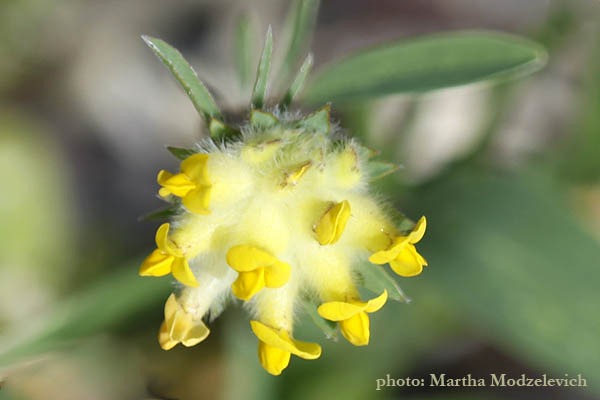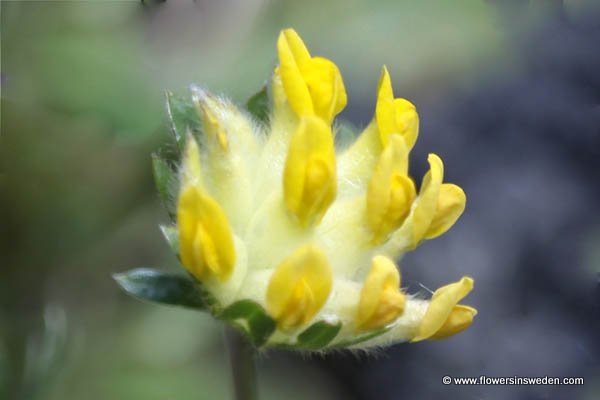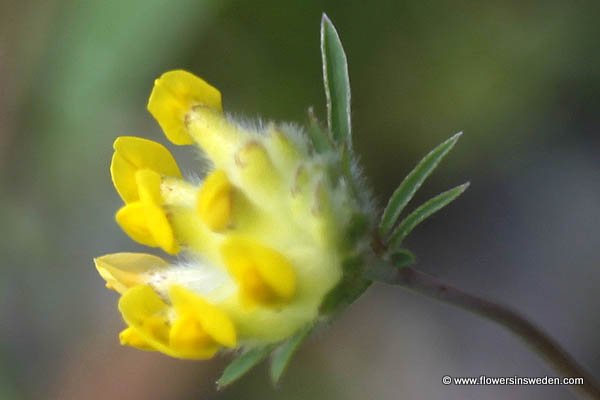
| Scientific name: | Anthyllis vulneraria L. | |
| Synonym name: | Anthyllis alpestris Hegetschweiler-Bodmer, Anthyllis dillenii Schult. ex Steud., Anthyllis linnaei (Sagorski) Juz., Anthyllis vulneraria subsp. corbierei (C.E.Salmon & Travis) Cullen | |
| Swedish name: | Getväppling | |
| German name: | Echter Wundklee, Gemeiner Wundklee, Gewöhnlicher Wundklee | |
| Nederlandse naam: | Wondklaver | |
| English name: | Common kidneyvetch, Kidney vetch | |
| Plant Family: | Fabaceae / Leguminosae, Bean family, Ärtväxter |

|
| Life form: | Perennial, hemicryptophyte | |
| Stems: | Height 10–40 cm, creeping–erect | |
| Leaves: | Alternate,broadly oblong or ovate, imparipinnate, glabrous or with scattered hairs on the upper face and silky hairs on the underside | |
| Flowers: | Spherical flower heads, hermaphrodite, calyx with 5 short, unequal lobes; corolla, yellow to orange, rarely red | |
| Flowering Period: | June, July, August | |
| Fruits: | 1-seeded legume about 3mm, enclosed in the calyx | |
| Habitat: | dry calcareous soils, such as roadsides, in yards, limestone and mountain slopes |

Derivation of the botanical name: Anthyllis, anthos blossom, ioulos beard, down, from the silky bristles of the calyx; ancient plant name used by Dioscorides. vulneraria, Latin vulnus wound; wounded, damaged; was supposed to be a cure for wounds. alpestris, of the lower mountains, growing in the mountains. dillenii, named for Johann Jacob Dillen (Latinized to Dillenius), 18th century German botanist and physician. linnaei, named for Carolus Linnaeus (1707 - 1778), the father of modern taxonomy.
Anthyllis vulneraria (yellow), had a higher max. sugar crop. Pedanius Dioscorides (circa 40 — 90 CE) mentioned in "The Greek Herbal of Dioscorides" Anthyllis. Anthyllis [but some call it Anthyllon, some Anthemis, some Eranthemis, some Leucanthemon, some Soranthis, some Flos campestris, ye Romans Solaster] is twofold, for one hath leaves like unto Lens, & a little branches ye heighth of a span, but upright, & ye leaves soft, but ye root slender & little. It grows in sandy & sunny places, somewhat salt to ye taster. But ye other kind, is like in ye leaves & small branches to Chamepitys but they are rougher & shorter & sharper. The flower is of a purple colour, smelling extremly strong, ye root as it were of Cichorie. It is of force mightily to help ye dysureticall & nephriticall, being drank ye quantity of 4 dragms. But being beaten small, & given as a Pessum with Rosaceum & milk, they do mollify ye inflammations which are in ye matrix. They do also heal wounds, but that which is like Chamepitys amongst other things, doth heal also ye Epilepticall being drank with Oxymel. 
|